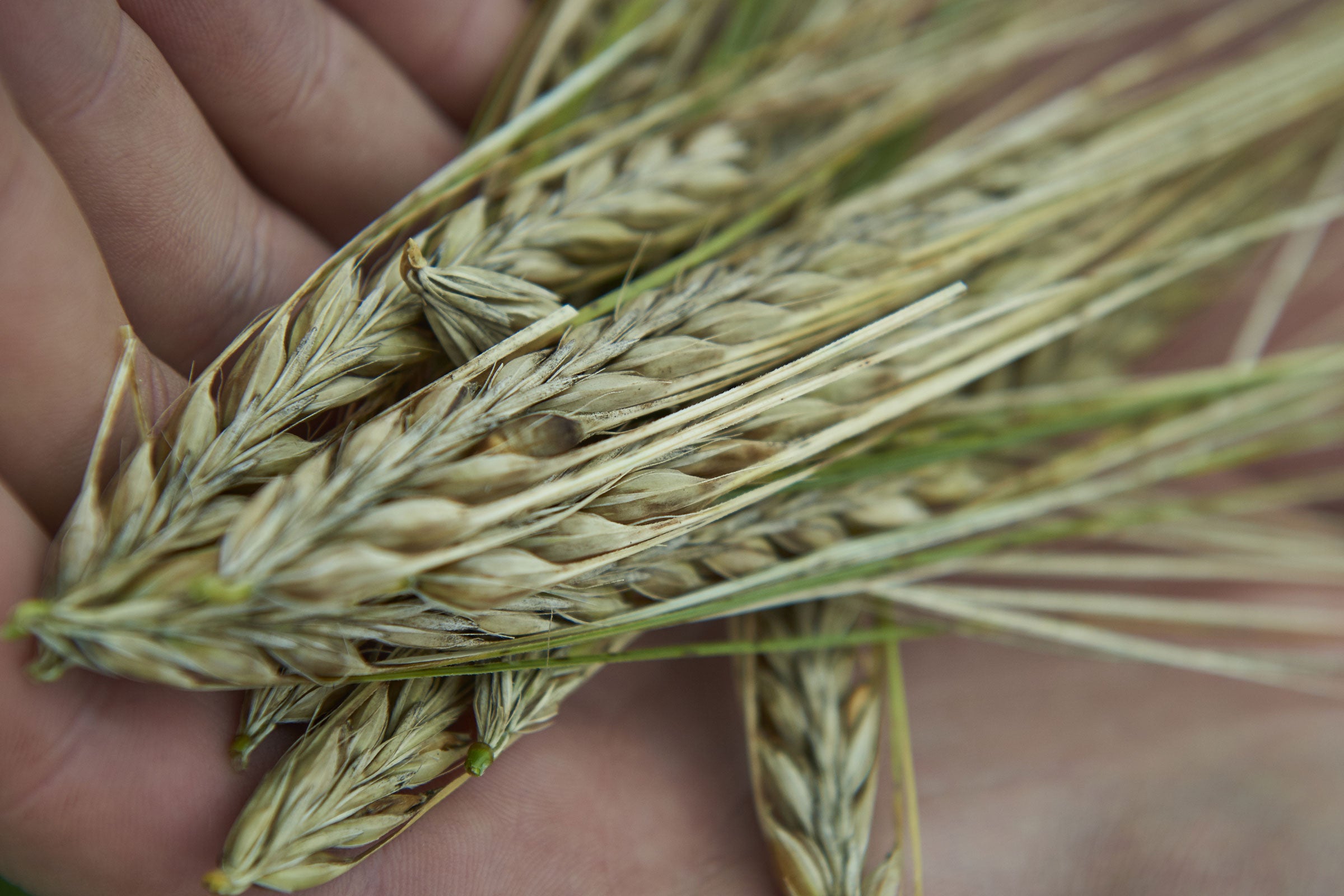- Shop
- Recipes
- About
- Sign in
-
Shop
-
Recipes
-
About
by Nick Saltmarsh August 16, 2023
|
Naked barley was the first cereal crop we introduced to our range at Hodmedod, inspired by the research of Edward Dickin, Katherine Steele and others to see the potential of almost forgotten naked varieties of barley, grown as a resilient and beneficial part of diverse arable rotations, to provide nutritious, versatile and tasty food. We now work with crops of varieties developed by Edward Dickin to produce a wide range of naked barley wholefood products - wholegrain, pearled, kibbled, flour, flakes and ferment. |
Neither the earliest domesticated barley, Hordeum vulgare, one of the founder crops first grown in the Fertile Crescent around 10,000 years ago, nor its wild ancestor, Hordeum spontaneum, were naked. Instead each grain of barley is enclosed in a tightly adhered inedible husk, formed from the outer parts of the barley flower or pales.
Barley with the husk firmly stuck to the grain is known as hulled or covered. Before it's eaten the husk has to be removed, for example by abrasive pearling, but covered barley is better suited to malting for the brewing of beer, the main use for barley since the 19th century.
Around 8,000 years ago a single genetic mutation of the Nud gene occurred in a barley plant in northern Iran, removing its ability to produce the glue that sticks the husk to the grain. The naked barley grain from plants with the mutation freely shed its husks when harvested and threshed.
Naked barley grains could be eaten without the need for any further processing to remove the husk, a benefit to the early farmers growing barley for food that outweighed its poorer germination (from the less protected grain) and lower yields. Grains from the original mutant plant were saved, grown and shared, rapidly spreading across Asia, North Africa and Europe.
Barley was the most grown cereal through the Neolithic, Bronze and Iron Ages, particularly naked barley, before the spread of higher gluten wheat more suitable for making risen bread. As barley became more used for animal feed and for malting and brewing, the lower yielding naked types fell out favour and covered barley was more widely grown.
Modern breeding of barley since the 19th century has been focused almost exclusively on covered varieties to the extent that naked barley has been barely grown for over a hundred years in many of the most productive arable regions.
Barley has a short growing season and is the most adaptable of all cereal crops, growing well at northerly latitudes and at high altitude and tolerant of both salt water and drought. It remained the most popular cereal crop on the highland, coastal and desert fringes of agriculture, from the Scottish Highland and Islands to the Himalayas.
In some of these remote areas naked landraces continued to be grown and their genetic potential was retained. Recent breeding programmes to develop new vigorous, disease-resistant and consistent naked barley varieties, that are well-suited to the British climate, have drawn on the genetic resources of these historic landaces.
Barley is a valuable source of nutrition particularly, like oats, as a good source of beta-glucan, a type of soluble fibre that has been shown to lower blood sugar spikes and blood cholesterol. Barley therefore has the potential to reduce risk factors for coronary heart disease, type-2 diabetes and obesity. Many naked barleys have significantly higher beta-glucan levels than modern covered varieties.
Barley can also play a valuable role in less resource-intensive arable rotations as a low-input crop, requiring less fertiliser and water than wheat.
The potential of naked barley is increasingly widely recognised, particularly as a healthy, sustainable and versatile food but also for other uses. Although it all but disappeared from mainstream farming and remains very little grown, there will surely be a lot more naked barley grown and eaten in the future.
Find our naked barley products...

August 14, 2025
Hodmedod co-founder Josiah Meldrum describes how Hodmedod emerged from the question of whether we can reliably and sustainably feed ourselves.
August 13, 2025
Our new organic naked fava beans and yellow peas can be used just like split beans and peas - there are just a few intact whole pulses that will generally split in half when soaked and cooked. But why are some of our beans & peas now naked?
June 27, 2025
Get in touch at hello@hodmedods.co.uk or 01986 467567
Things sometimes go wrong but we'll always do our best to put it right. Please contact us to let us know if there's any problem with an order.
For further details please see our Terms of Service, Returns, Refunds and Exchanges Policy and Privacy Policy.
Sign up for our latest news, recipes, offers & more…
By signing up, you agree to receive marketing emails. Please see our Privacy Policy for more details.
Registered in England and Wales as Hodmedod Ltd, The Studios, London Road, Brampton, Beccles, Suffolk, NR34 8DQ, UK; company number 08151811.
